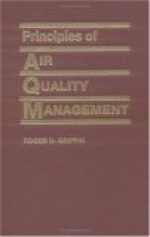Tab Article
Principles of Air Quality Management presents the fundamental principles that make up the broad field of air quality, pollution, and management. It is intended for those who have a general interest in the field, as well as those who have been involved in possibly only one or two of the specific aspects of air quality management. The book provides an understanding of the principles that govern our ability to manage air quality resources. It brings together in one volume current information on clean fuels, control technology, health effects, regulations, indoor air quality, global concerns, sources of criteria and hazardous air pollutants, atmospheric dispersion and modeling, air quality standards, risk assessments of air toxics, and trends. Beginning with the make-up of air and definitions of air and air pollution, this book outlines the history of air quality management, discussing emissions, standards, classifications of pollutants, and the production of secondary air pollution or photochemical smog.The discussion continues with the health effects of air pollutants and those that are considered toxic or hazardous, and the effects of those contaminants on the human body. Air pollutant damage to materials and vegetation, the standards of acceptable air quality from a health impacts outlook, and the techniques for measuring air quality are also reviewed.Air contaminant sources are approached from anthropogenic, geogenic, and biogenic viewpoints. From local, regional, and global perspectives, the book examines how contaminants are dispersed between sources and receptors. From these studies, an evaluation is made of the different models used to calculate dispersion and of the models used to predict ambient air quality. Federal laws and regulations, as well as regional perspectives, are summarized and evaluated. Control technologies available for both stationary sources and mobile sources are reviewed. From these sources, management options for limiting emissions and optimizing air pollutant strategies are analyzed. Also included is the latest data from the Auto/Oil Program on the impact of fuel reformulation on engine tailpipe emissions, the conclusions of the MECCA group on global warming, the findings of the California Healthy Building Pilot Study on indoor air quality, and the requirements for federal permits under the Clean Air Act Amendments. Global air quality concerns, relative global emissions, and alternative views are evaluated from a management options perspective. The book concludes with a presentation of indoor air quality and future trends in air quality management approaches, as well as their limitations.


